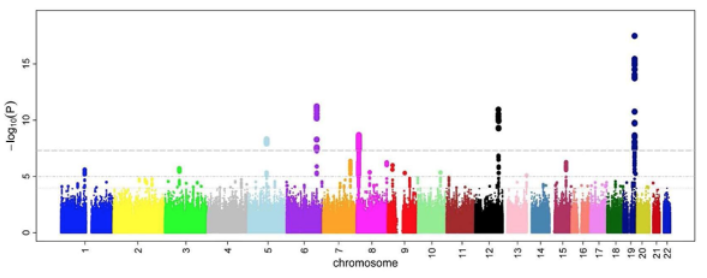Exploring the GEnetics of NEUropathic Pain – The GeNeup study
THE PROJECT
In the GeNeup study, we investigate whether gene variation can help explain why some people with polyneuropathy (nerve damage in hands and/or feet) develop neuropathic pain (nerve pain), while others do not. In addition, we test the properties of various tools intended to assess polyneuropathy and neuropathic pain.
GOALS
Gene mapping increases knowledge about the mechanisms that underlie the development of neuropathic pain. This could potentially lay the foundation for more effective medications than what is available today. Furthermore, we aim to improve the diagnosis of both polyneuropathy and neuropathic pain.

HOW DO WE ACHIEVE THE GOALS?
We have recruited individuals with [suspected] polyneuropathy and conducted thorough clinical examinations. We also took blood samples to map their genes. Various tools used in the clinical examination were compared with those considered to be the most accurate. The final step is to map the genes of the participants, looking for correlations between genetic variations and the development of nerve pain. We have now processed all the blood samples and will perform genetic analyses in 2024.

WHAT HAVE WE FOUND SO FAR?
- In examining the thinnest nerve fibers, patients are often tested for their ability to feel heat or cold. We found that protocols involving comparing body areas, like the right foot against the left, or thigh against calf, yield uncertain diagnostic information.
- For patients with diabetic polyneuropathy, we discovered that measuring the function of five different nerves in the legs and combining these findings into one combined score provides a good picture of the disease. This method is sensitive to changes and is well suited for monitoring patients over time.
- In a larger genetic analysis of patients with idiopathic polyneuropathy (unknown cause of disease), we identified two genes associated with the disease. These genes suggest that possible disease mechanisms involve changes in inflammatory response and nerve regeneration. We also found a correlation between anthropometry (especially height) and pain.
- We examined three of the most commonly used clinical tools for diagnosing neuropathic pain and found that they performed poorly on patients with polyneuropathy. It appears that these tools incorrectly identify common signs of polyneuropathy, and cannot distinguish these from signs that the patients’ pain are neuropathic in nature.
- One of the most used tools to diagnose polyneuropathy is the monofilament test. We investigated how well the Norwegian version of this method worked, and found that the test was not reliable. It was weak in detecting disease, and performed especially poorly among female patients, older adults and patients with neuropathic pain.
PUBLICATIONS
1: Dunker Ø, Lie MU, Nilsen KB. Can within-subject comparisons of thermal thresholds be used for diagnostic purposes? Clin Neurophysiol Pract. 2021 Feb 4;6:63-71. doi: 10.1016/j.cnp.2021.01.002. PMID: 33665518; PMCID: PMC7905396.
2: Dunker Ø, Nilsen KB, Olsen SE, Åsvold BO, Bjørgaas MRR, Sand T. Which combined nerve conduction study scores are best suited for polyneuropathy in diabetic patients? Muscle Nerve. 2022 Feb;65(2):171-179. doi: 10.1002/mus.27445. Epub 2021 Nov 5. PMID: 34687224.
3: Winsvold BS, Kitsos I, Thomas LF, Skogholt AH, Gabrielsen ME, Zwart JA, Nilsen KB. Genome-Wide Association Study of 2,093 Cases With Idiopathic Polyneuropathy and 445,256 Controls Identifies First Susceptibility Loci. Front Neurol. 2021 Dec 17;12:789093. doi: 10.3389/fneur.2021.789093. PMID: 34975738; PMCID: PMC8718917
4: Dunker Ø, Grotle M, Bu Kvaløy M, Uglem M, Løseth S, Hjelland IE, Kleggetveit IP, Allen SM, Dehli Vigeland M, Munk Killingmo R, Sand T, Nilsen KB (2022) Accuracy of neuropathic pain measurements in patients with symptoms of polyneuropathy: validation of painDETECT, Self-Completed Leeds Assessment of Neuropathic Symptoms and Signs, and Douleur Neuropathique 4 Pain, 164 (5), 991-1001 doi: 10.1097/j.pain.0000000000002793, PMID: 36240023
5: Dunker Ø, Grotle M, Nilsen KB (2023) Validating clinical tools for neuropathic pain: should negative studies be thrown out? Reply to Attal and Bouhassira. Pain, 164 (5), e261 doi: 10.1097/j.pain.0000000000002908, PMID: 37058694
6: Dunker Ø, Uglem M, Bu Kvaløy M, Løseth S, Hjelland IE, Allen SM, Dehli Vigeland M, Kleggetveit IP, Sand T, Nilsen KB (2023) Diagnostic accuracy of the 5.07 monofilament test for diabetes polyneuropathy: influence of age, sex, neuropathic pain and neuropathy severity BMJ Open Diabetes Res Care, 11 (6) doi: 10.1136/bmjdrc-2023-003545, PMID: 37989346
